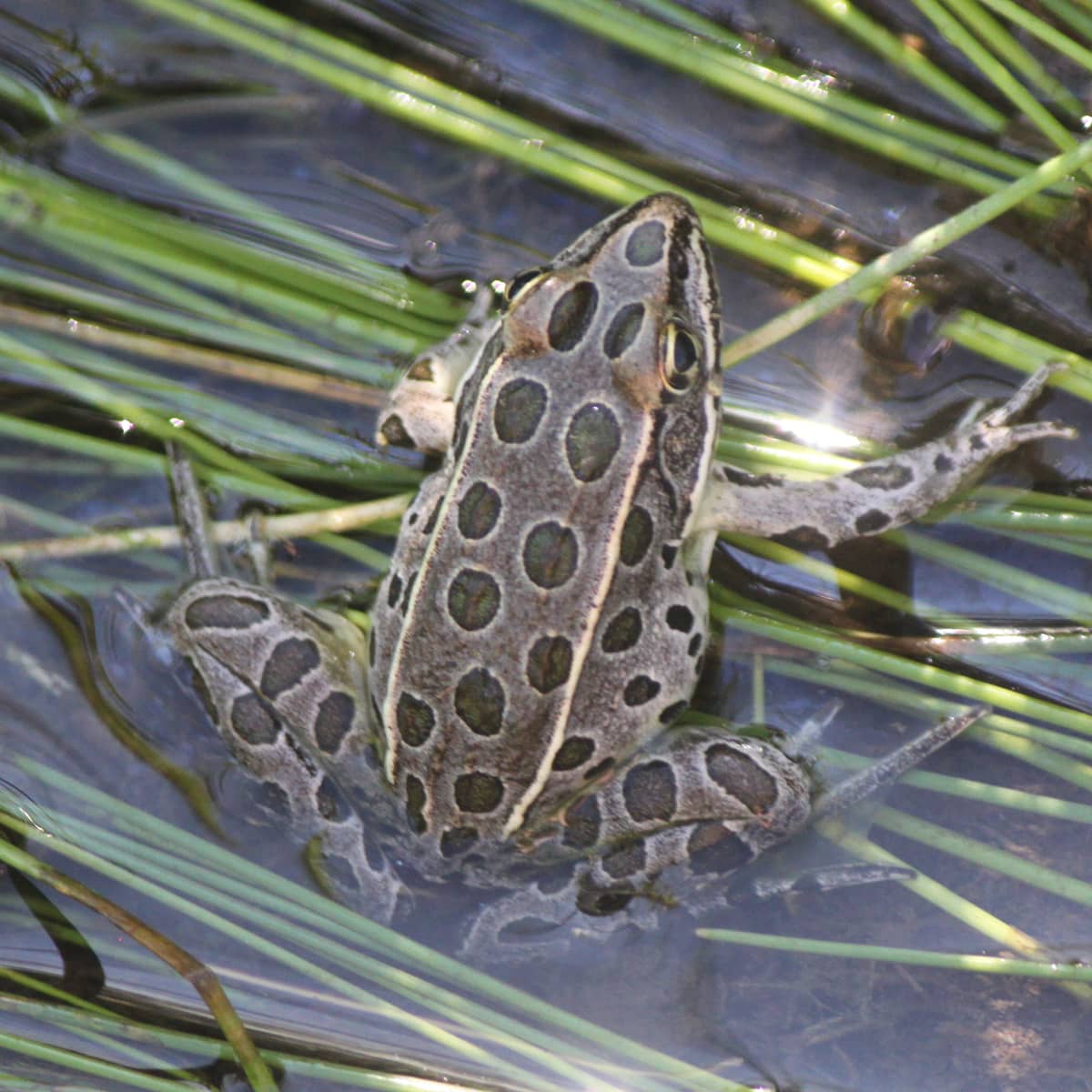
Hope Hops. A northern leopard frog relaxes in the sunny vegetation alongside a small creek. Identifying those living creatures – from fish to frogs to foxes to ferns – is a vital part of understanding ecology, and oftentimes helps with success in angling and hunting. Simonson Photo.
By Nick Simonson
Atop the tank of the basement toilet, where any good publication of any sort rests in any household, sits a well-worn copy of the National Audubon Society Field Guide to North American Reptiles and Amphibians. As a smaller reference book, it tops of the stack of old Outdoor Life and Dakota Country magazines and sets perfectly on the foundation of the Complete Outdoor Encyclopedia, finishing off the easy access pyramid of print. The crown jewel of my bathroom reading with the emerald leather cover and the slightly torn half dust jacket with a full color photo of a green tree frog reminds me of where my outdoor adventures began and perhaps suggests where those of my progeny are heading.
Long before fishing was at the forefront of my summers, and well ahead of upland hunting filling my falls, I was obsessed with frogs, toads, salamanders, turtles, and lizards from the first spring evening where the air filled with a chorus of croaks to the migration of just-hatched baby snappers through the neighborhood back to the river in the fall. In each of the window wells around my grandmother’s cabin in Detroit Lakes, Minn., in the basement of the farmhouse of my babysitter’s parent’s farm in Nome, N.D., and in the backwater muck of the ponds under the Hi-Line bridge along the Sheyenne River north of our house in Valley City, N.D., I’d search for all the area had to offer. While limited in species to northern leopard frogs, wood frogs, spadefoot toads, snapping turtles, garter snakes, skinks and the handful of other cold-blooded creatures that are adaptable enough to call our sometimes-challenging region home, family trips to the panhandle of Florida opened my world of herpetological experience.
There in the warmth of pre-Easter March or April, I’d chase anoles across the wooden walkways surrounding the pool at my grandmother’s condominium, watching them shift from green to brown as they made the jump from decorative hedge row to deck railing. I’d scoop from the grassy edges of the water hazards of area golf courses the eggs and tadpoles of unknown amphibians in hopes of transporting some home via a pre-Delta Northwest Airlines to see what they’d turn into. In the shade of the stations of the cross walkway behind the church up the road, mixed in with the palmetto bugs were the bright skinned green tree frogs so vibrant that they rivaled the one on cover on the field guide I used to identify them. Luckily one day, after having a good grasp of most of the poisonous species within the compendium and out stalking new specimens, I was able to recall in the moment from memory the outline of a cottonmouth’s head and decided to pass on attempting to capture the juvenile snake of about 16 inches in length which was swimming alongside a school of tadpoles in a water hazard at the par three pitch-and-putt my parents were playing. I won’t go so far as to say the hand-held reference saved my life, but it just might have.
I took my passion for the small book and the creatures within it to state and national Science Olympiad in high school, finishing in the top three at the state competition for the two years the Reptiles & Amphibians event was conducted, and notched a top 15 finish at the national event as a Sophomore. At this point, one can easily imagine my heightened level of disappointment when the event organizers rotated tree and plant identification in for my final two years on the team. While I purchased a similar Audubon Society guide for that event, my passion for tree identification never took root as deeply as my love of reptiles and amphibians.
But maybe, my curiosity for picking those things out in our natural world and learning more about them has been passed along to my oldest son, as this weekend he spent a good stretch of time utilizing his mother’s phone in the house and around the yard. Using an application called PictureThis he snapped photos of various plants that inhabit our yard, and those flowers in the vases inside. With each click of the camera button, the program would match the photo with its digital database and provide the name of the species and its traits on the screen which he would read aloud. From the Canada thistles standing guard alongside the house and the dandelions interspersed in the lawn to the ivy on the back wall and the showy lily in the foyer bouquet, he’d warn of threats the plants posed to our pets, the notable identifiers on each and other elements of interest. His research went on until phone time ended.
In a world where technology and instant information dominate his day and the turning of a page is no longer a requirement for learning, it’s nice to see a sense of exploration of the natural world arise from the growing virtual reality that competes for his attention. Because whether it’s a field guide with paper and glossy pictorials that fueled my love of all that hopped, crawled, and slithered, or the snap-and-scan of an app that provides some added insight to what makes up the greenery around my eight-year-old, whatever gets a person outside and exploring, I’ll refer to as an ally…in our outdoors.
